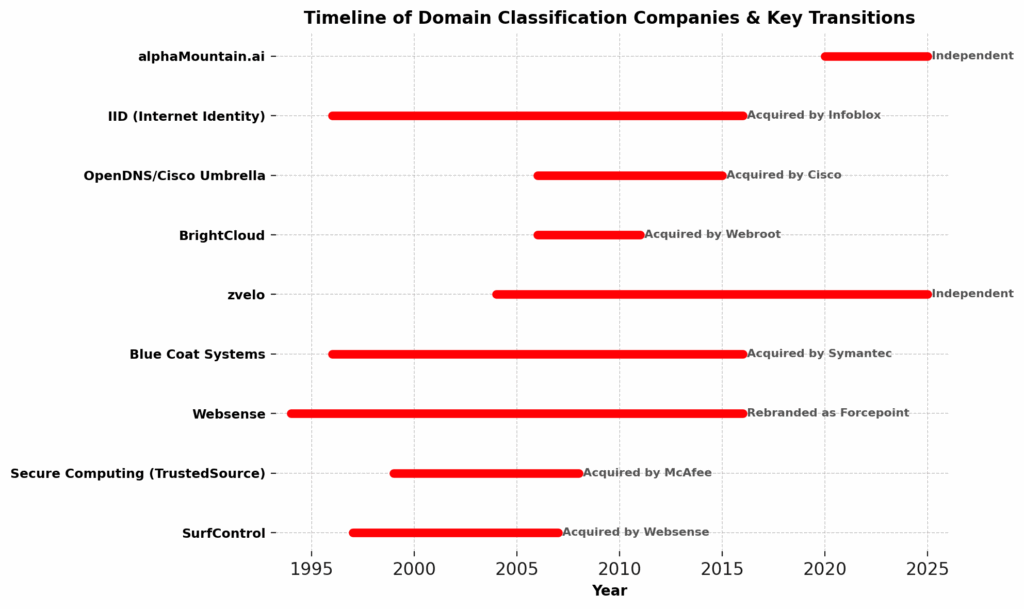What Is Domain Classification?
Domain classification is the process of assigning categories or reputational scores to a web domain or URL, typically based on its content, ownership, behavior, or security posture. In cybersecurity, it’s not just about labeling a site “News” or “Sports.” It’s about knowing whether that site poses a risk, engages in phishing, distributes malware, or impersonates a legitimate brand.
A Historical Timeline of Domain Classification Providers
The history of domain classification parallels the internet’s growth — evolving from simple content filtering into sophisticated, scalable AI-powered threat intelligence feeds.
1990s — First Steps: Static Category Lists
-
SurfControl (Founded 1997, UK)
One of the earliest commercial URL filtering providers. It maintained manually curated lists of domains in categories like “Adult Content” or “Gambling” to help schools and businesses block inappropriate material. Acquired by Websense in 2007. -
Secure Computing Corporation (TrustedSource)
In the late 1990s, SCC began developing TrustedSource, an IP and domain reputation engine that categorized domains and scored their risk level. This technology would later become part of McAfee’s security products.
Early 2000s — Reputation Meets Categorization
-
Websense (Founded 1994, USA)
Evolved beyond simple blocking lists to offer dynamic categorization and real-time updates. Websense’s database became a standard in enterprise web filtering before it rebranded to Forcepoint in 2016. -
Blue Coat Systems (WebFilter)
Offered a cloud-assisted URL classification service that powered their secure web gateway appliances. Blue Coat’s WebFilter database became widely licensed across OEM partners. Acquired by Symantec in 2016. Fun fact: Part of alphaMountain’s executive team spent time at Blue Coat and through its acquisition.
Mid-2000s — Security Vendors Go All-In
-
BrightCloud (Founded 2006, USA)
Introduced cloud-based web reputation and classification services. Lesser-known product in the wide-ranging OpenText portfolio. Acquired by Webroot in 2011, now part of OpenText. -
zvelo (Founded 2004, USA)
Focused on URL categorization with a large category taxonomy for ad tech platforms and ISPs. Known for its ~500 categories, the vast majority of which are not cybersecurity related.
2010s — Machine Learning and Threat Intelligence Integration
-
Cisco Umbrella (formerly OpenDNS)
OpenDNS started as a consumer-friendly DNS service in 2006 but pivoted to security with domain categorization and malicious domain blocking. Cisco acquired it in 2015, creating Cisco Umbrella. -
Forcepoint (formerly Websense)
Expanded classification into insider threat and behavioral analytics, integrating web category data into a larger risk management ecosystem. -
Infoblox / IID (Internet Identity)
IID, founded in 1996, specialized in domain reputation and anti-phishing intelligence. Acquired by Infoblox in 2016 to enhance their DNS security platform.
2020s — Real-Time, AI-Powered, First-Party Intelligence
-
alphaMountain.ai
Brings AI and machine learning to domain classification with real-time scoring, 89 granular categories, and first-party threat intelligence. Data is collected and analyzed directly, not aggregated from third parties.Unlike earlier players that relied on static lists or slow update cycles, alphaMountain classifies new domains as they emerge — a critical advantage in an era where malicious domains often exist for less than 24 hours.
Today’s Use Cases for Domain Classification
- Secure Web Gateways & Firewalls
Apply policy controls to web traffic based on category and risk score. (See our Web Classification Guide) - Phishing & Smishing Prevention
Classify URLs in emails or text messages in real time, blocking malicious links before users click. - Brand Protection & Fraud Detection
Identify impersonation domains, typo-squatting, and other brand abuse indicators. - SOC Automation
Enrich alerts with category and reputation data to speed incident triage and reduce false positives. - Secure Browsing
Enforce web browsing policies and meet client-level access control requirements.
alphaMountain: Leading the Next Era of Domain Classification
-
First-Party, AI-Driven Data — No dependency on slow third-party aggregators.
-
Real-Time Threat Ratings — Fresh intelligence for domains that may exist only for hours.
-
89 Category Taxonomy — Covering everything from “Cloud Services” to “Alternative Currency.”
-
Rich Context — Includes WHOIS, pDNS, SSL certs, shared infrastructure, and screenshots.
For developers and security architects, alphaMountain offers flexible APIs and feeds that drop seamlessly into secure web gateways, SIEMs, SOAR platforms, and investigative tools.
Don’t hesitate to contact us if are looking to improve the threat detection of your cybersecurity solutions.


